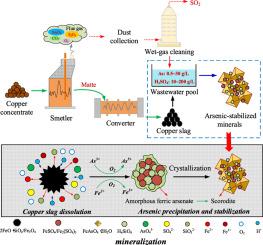Journal of Cleaner Production ( IF 9.7 ) Pub Date : 2020-05-27 , DOI: 10.1016/j.jclepro.2020.122428 Yongkui Li , Xing Zhu , Xianjin Qi , Bo Shu , Xin Zhang , Kongzhai Li , Yonggang Wei , Fengyan Hao , Hua Wang

|
Copper smelting wastewater, one of the typical high arsenic-containing acidic wastewater in the metallurgical extraction process of arsenic-associated minerals, greatly threatens human health and ecological safety due to the possible leakage and diffusion from its secondary pollution. However, the state-of-the-art technologies suffer from the great challenge that the disposal of wastewater emits an enormous amount of arsenic-containing hazardous wastes with the poor long-term stability and the high arsenic leachability. Herein, a novel strategy is proposed to remove and stabilize arsenic from copper smelting wastewater in the form of environmental friendly scorodite using copper slag as a neutralizer and an in situ iron donator. The thermodynamic analysis and the bath experiments were investigated to explore the reaction behavior between wastewater and copper slag. The result shows that 97.86% of arsenic was successfully removed from wastewater with an initial arsenic concentration of 10230 g/L at by using copper slag at an Fe/As molar ratio of 2.0 and 80 °C for 12 h, resulting in a scorodite-SiO2-sulfate composite with an arsenic leached concentration of 3 mg/L in the leaching test. The main phases of Fe2SiO4 and Fe3O4 from copper slag dissolve in wastewater and release abundant Fe ions to synthesize scorodite and secondary minerals (silica gel and sulfate complexes). The initial precipitates from the second minerals are likely to serve as nucleation sites for the formation and growth of scorodite. We demonstrate an inherent arsenic disposal process for the copper smelting industries, and the process allows the removal and stabilization of arsenic from wastewater using solid waste. It might provide an efficient and low-cost solution for the disposal of arsenic-containing wastewater in the nonferrous smelting industry.
中文翻译:

利用铜渣有效去除臭葱石形式的铜冶炼废水中的砷
铜冶炼废水是砷相关矿物冶金提取过程中典型的高砷酸性废水之一,由于其二次污染可能造成泄漏和扩散,极大地威胁着人类健康和生态安全。然而,最先进的技术面临着巨大的挑战,即废水的处理会释放出大量的含砷危险废物,其长期稳定性差且砷的浸出能力高。在此,提出了一种新的策略,以铜渣作为中和剂,就地从铜冶炼废水中去除砷并稳定了环境臭葱石形式的砷。铁捐赠者。通过热力学分析和水浴实验研究了废水与铜渣之间的反应行为。结果表明,通过使用Fe / As摩尔比为2.0和80°C的铜渣处理12 h,从初始砷浓度为10230 g / L的废水中成功去除了97.86%的砷,从而产生臭葱石-在浸出试验中,砷浸出浓度为3 mg / L的SiO 2-硫酸盐复合材料。Fe 2 SiO 4和Fe 3 O 4的主要相铜渣中的铜溶解在废水中并释放出大量的铁离子,从而合成臭葱石和次要矿物(硅胶和硫酸盐配合物)。来自第二种矿物的初始沉淀物很可能充当臭葱石形成和生长的成核位点。我们展示了铜冶炼行业固有的砷处理工艺,该工艺允许使用固体废物从废水中去除和稳定砷。它可能为有色冶炼行业中的含砷废水处理提供一种有效且低成本的解决方案。


















































 京公网安备 11010802027423号
京公网安备 11010802027423号